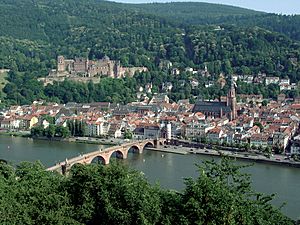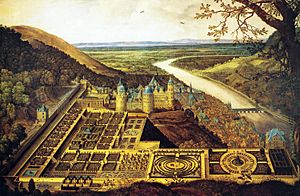Siege of Heidelberg (1622) facts for kids
Quick facts for kids Siege of Heidelberg |
|||||||
|---|---|---|---|---|---|---|---|
| Part of the Palatinate phase of the Thirty Years' War | |||||||
 View of Heidelberg with the Heidelberg Castle on hill and the Old Bridge. |
|||||||
|
|||||||
| Belligerents | |||||||
| Commanders and leaders | |||||||
| Strength | |||||||
| Approx: 15,000–21,000 | Approx: 22,000–30,000 | ||||||
| Casualties and losses | |||||||
| Unknown: 8,000 | Unknown: 5,000 | ||||||
The Siege of Heidelberg was an important battle during the Thirty Years' War. It happened in 1622 in Heidelberg, a city in a region called the Electorate of the Palatinate (which is now part of Germany). This siege was part of a bigger fight known as the Palatinate campaign.
The battle was fought between two main groups:
- The Imperial-Spanish army, led by Johan Tzerclaes, Count of Tilly and Don Gonzalo Fernández de Córdoba.
- The Anglo-Protestant forces, who supported Frederick V, Elector Palatine. Their commanders were Sir Gerard Herbert and Sir Horace Vere.
The siege lasted from July 23 to September 19, 1622. The Imperial-Spanish forces won, taking the city and its famous castle.
Contents
What Led to the Siege?
The Thirty Years' War Begins
The Thirty Years' War was a long and complex conflict in Europe. It involved many countries and was partly about religion (Protestants versus Catholics). The Electorate of the Palatinate was a key area in this war.
In 1620, a Spanish general named Don Ambrosio Spinola used a smart tactic. He tried to wear out his enemies slowly, hoping they would get tired and give up. This strategy is sometimes called "Fabian tactics."
Defending the Palatinate
Sir Horace Vere, an English commander, split his troops to defend three important strongholds in the Palatinate:
- Vere himself stayed in Mannheim.
- Sir Gerard Herbert was sent to defend Heidelberg Castle.
- Sir John Burroughs took charge of Frankenthal.
In early 1621, the Protestant Union, a group of Protestant states, broke apart. This meant the English soldiers defending these places couldn't expect much help.
Changing Fortunes
In 1622, Frederick V, Elector Palatine, who had lost his throne, visited his troops in Mannheim. He hoped to turn things around. He and another general, Ernst von Mansfeld, managed to briefly stop the Imperial army at Wiesloch.
However, things quickly changed. Count of Tilly's army got stronger when the Spanish army joined them. They defeated the Protestants and captured many German towns. By June, Frederick V had to leave Mannheim.
The Siege of Heidelberg Begins
Surrounded by Enemies
After these defeats, the Protestant forces, about 25,000 strong, moved to the western side of the Rhine river. They stopped trying to fight off the invasion of the Palatinate directly.
This left the English garrisons, including the one in Heidelberg, surrounded. The Imperial and Spanish armies, led by Tilly and Córdoba, began their attack on Heidelberg. Sir Horace Vere decided to hold out, even though he knew it would be very difficult.
A Distraction That Failed
In July 1622, the Protestant leaders decided to send some of their forces to the Netherlands. Their goal was to help lift the siege of Bergen-op-Zoom.
When the Spanish found out, Córdoba quickly went to stop them. He fought a bloody battle at Fleurus on August 29. Even though the battle was fierce, the siege of Bergen-op-Zoom still had to be stopped.
Heidelberg Falls
Despite the brave resistance, Heidelberg could not hold out forever. After 11 weeks of fighting, the city fell on September 19, 1622.
Sadly, Sir Gerard Herbert, the English commander defending Heidelberg, was badly wounded during the siege and later died.
What Happened Next?


After Heidelberg fell, the Spanish army continued to advance. They captured Mannheim, another important city. The Anglo-Protestant forces under Sir Horace Vere fought hard but were eventually defeated and had to surrender.
Only Frankenthal, defended by Sir John Burroughs, remained loyal to Frederick V, Elector Palatine. However, the Spanish troops took Frankenthal a year later. This meant the entire Electorate of the Palatinate was now controlled by the Spanish.
See also

